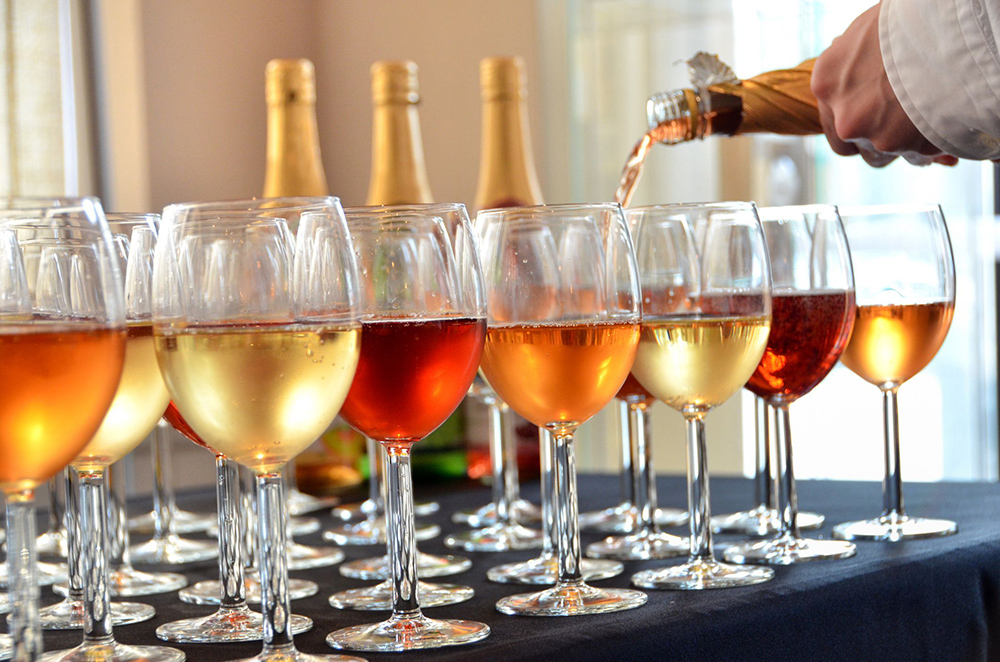By David Setley
August 13, 2023, was National Prosecco Day, a day in honor of the Italian sparkling wine. For those who don’t know, prosecco is to Italy as Champagne is to France and cava is to Spain. My favorite prosecco memory occurred a few years ago when I was traveling in Italy by train. When my wife asked if they had Sprite or ginger ale, the server said, “No, but we have prosecco.” Needless to say, we eagerly accepted and enjoyed mini-bottles of prosecco for the remainder of that train ride and every other time we could on that trip! So, pop a cork, pour a glass, and let’s take a moment to explore the history of prosecco and how it has come to be so popular.
The origin of prosecco dates back to around 200 B.C., although it did not become popular to the masses until the early 2000s. The earliest record of sparkling wine coming out of Northern Italy was about a wine called puccini, created by the Romans. In 1754, prosecco appeared in a poem by Aureliano Acanti in reference to a sparkling wine from the Prosecco wine region. In the 1940s, a famous drinking establishment in Venice called Harry’s Bar marketed the Bellini cocktail, a refreshing and bubbly beverage made from fresh peach puree and prosecco. Other cocktails using prosecco, such as the Aperol Spritz, grew in popularity later. By the year 2000, the world’s awareness of prosecco had grown rapidly, spiking sales. Worldwide, prosecco sales surpassed Champagne sales by 2013.
There are several similarities between prosecco and Champagne. Both are sparkling wines that, in order to carry the name, must be made in the proper wine region using the appropriate grape. The grape used to make prosecco was originally called the Prosecco grape but was re-named Glera in 2009 by the European Union. To be a prosecco DOC (Denominazione di Origine Controllata), the wine must contain no less than 85% Glera grapes. To carry the name, prosecco must also be made in the prosecco subregion of the Veneto wine region utilizing traditional production techniques. There are other sparkling wines from Italy beyond prosecco, but, according to Old World tradition, only those from the designated region can be identified by the name.
Despite their similarities, a common misconception among consumers is that prosecco is inferior to Champagne in terms of quality, perhaps because it is generally less expensive. Although a very good prosecco can be found for a fraction of the cost of an average Champagne, that is likely attributed to production costs rather than quality of the wine. Both prosecco and Champagne utilize a double fermentation process. In the first fermentation, the wines are made much like any other wine. In fact, there is a still version (without bubbles) of prosecco known as prosecco tranquillo. Only about 5% of prosecco wines produced are done so as prosecco tranquillo, and they are generally not exported out of Italy. It is the second fermentation process that can greatly affect cost. The second fermentation of Champagne occurs by injecting additional yeast into the individual bottles of the wine. Prosecco’s secondary fermentation takes place in a stainless-steel vat prior to bottling. The process of creating the effervescence in prosecco is much shorter – typically between 1 and 9 months – than the year plus needed for Champagne and is considerably more cost-effective.
Another myth is that prosecco is sweeter than Champagne when, in fact, there are variations of sweetness/dryness. The driest is Extra Brut, followed by Brut. Demi-Sec is the sweetest. If you are looking for maximum dryness in your prosecco, the Bele Casel Asolo Prosecco is a great choice. The aromas are fresh with notes of golden apple and a touch of grapefruit. Or, for a reasonably priced Brut Prosecco, try the NaoNis Prosecco DOC Brut. This lovely effervescent wine has an intense and stone fruit taste, with a fine and long-lasting finish, fresh and beautifully fragrant. The aroma is a bouquet of fruits and flowers. For my long-time readers, you may recall my mention of Montinore Estates from the Willamette Valley in Oregon. They also have a winery located in Prosecco, Italy where they produce Vivacé Prosecco DOC, a lovely prosecco with floral aromas of wildflowers and notes of lemon zest and pear. The flavors feature white peach, lemongrass, honeysuckle and melon and offer a lingering finish.
I would highly recommend any of these as a stand-alone glass of bubbly for any special occasion. Or, if you’re looking for a more interesting use of prosecco, try an Aperol Spritz. Although hotly debated across Northern Italy, Venice claims to be the birthplace of the classic Italian summer cocktail. My favorite recipe for an Aperol Spritz is as easy as 3-2-1. Over ice, stir together 3 parts prosecco, 2 parts Aperol, and 1 part club soda; squeeze in a wedge of fresh orange. Delicious and refreshing!
Although National Prosecco Day is a few days past, take time to enjoy a glass this week. As always, if you have any questions or comments, contact me at dsetley@passionvines.com or stop by the Somers Point store. Until next time, happy wining!
David Setley is enjoying his retirement from higher education as a wine educator and certified sommelier at Passion Vines in Somers Point, New Jersey.










